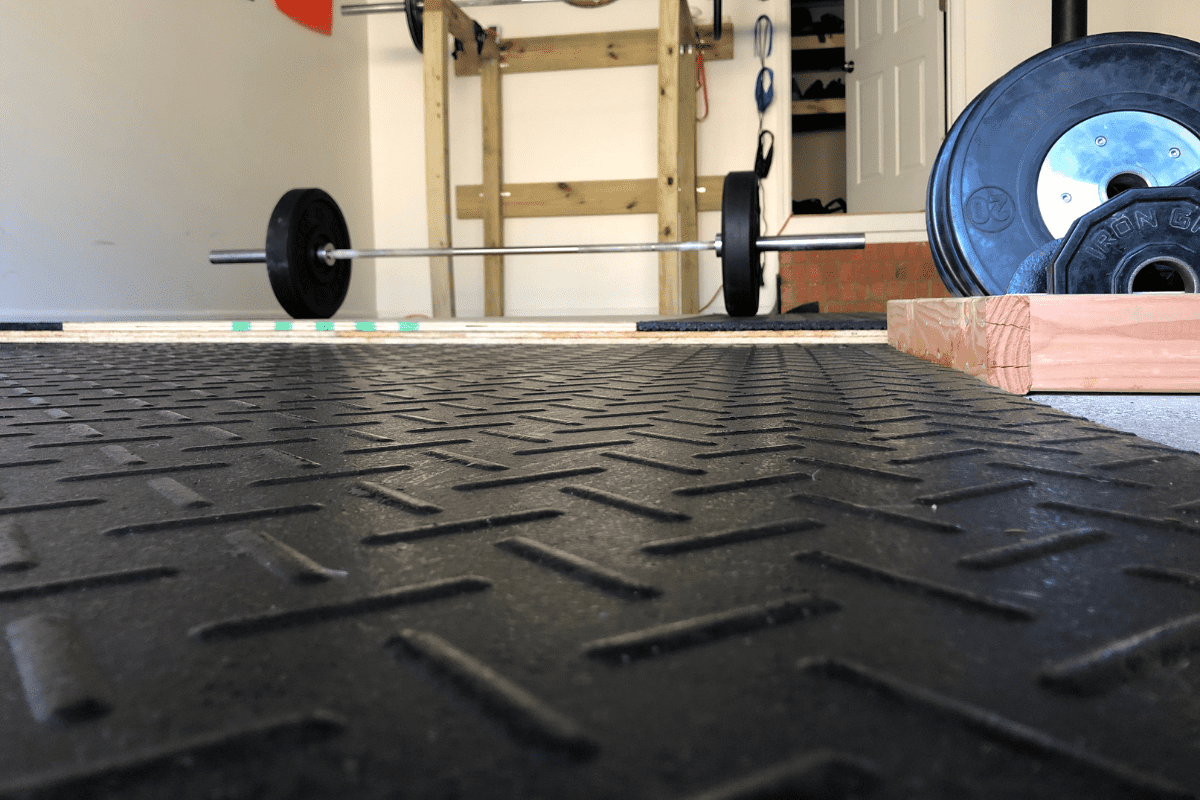What’s the Best Flooring for a Garage Gym? (Updated 2024)
Picking out garage gym flooring for your garage gym is a big decision because it’s literally the foundation for your gym. Laying down a gym floor is what takes a collection of lifting equipment sitting in your garage to a full fledged gym.
It’s also a big decision because, for many of us, this is often the first real investment into your home gym setup.
Putting some dumbbells and other gym equipment here or there on the concrete floor in your garage is one thing, but dropping a couple hundred dollars (or more) on garage gym flooring is a different level of commitment. Laying down gym flooring is essentially the equivalent of your garage gym ‘marking it’s territory’.
Sure you can still technically drive your car up onto rubber flooring, but the gym flooring itself defines the space of your garage gym.
So what kind of flooring should you get for your garage gym? This is going to depend a bit on what type of lifting/working out you do. Someone who Deadlifts heavy weight is going to have different flooring needs than someone predominantly doing bodyweight workouts.
There are two different types of commercial gym flooring, tile and rolled, and a third that I’ll discuss later. After I give you my best flooring for a garage gym I’ll give you answer to a lot of frequently asked questions when it comes to choosing garage gym flooring.
[toc]This post contains affiliate links. If you use these links to buy something I may earn a commission. Thanks.
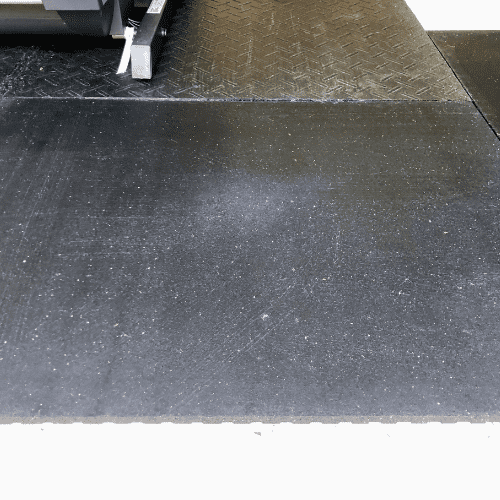
Northern Tool Stall Mat
Thick, durable, versatile and very cost-efficient. The perfect combo for a garage gym floor.

Anji MTX Exercise Platform
Great looking floor that is perfect for low impact workouts.

Plae Flooring
Best available flooring if you have the budget. (Our Temple weight room floor shown above)
Flooring Rolls vs Interlocking Tiles vs Rubber Mats
The three most popular types of garage gym flooring come in either rubber tiles, rolls or mats.
All three types of garage gym flooring do share some similarities. All are made of recycled rubber. You may have heard of ‘virgin rubber’ that’s used in some bumper plates.
When it comes to flooring options, though, there is no such thing as virgin rubber flooring. Even if there was, it would be so crazy expensive that hardly any of us would be able to afford it anyway.
The other thing all these floors have in common is that in my opinion, the most important aspect of them will be how thick they are. And when it comes to garage gym flooring, the thicker the better.
Now I’m going to go through each type of gym flooring and what differentiates each one from the others. I’ll also give you at least one recommendation of each that may be a good fit for your home gym.
Garage Gym Flooring – Rubber Mats
I’m going to start with rubber mats because I think that for most garage gym owners, rubber mats are going to be the best choice for their home gyms.
Why?
Because with gym mats, you can get the most bang for your buck. Not only are they generally cheaper per square foot, but they’re also thick and extremely durable. That’s crucial for anyone that’s lifting heavy weights.
Northern Tool Horse Stall Mats

Northern Tool Red Barn Button/Flat Dual Surface Mat
Northern Tool Stall Mats come in 3′ x 4′ rectangles and are 3/4″ thick. The thickness is extremely important for a garage gym, especially if you plan on dropping weights.
The size of the mat is a perfect balance. It’s large enough to still cover a good amount of floor space, but small enough to be versatile in tight spaces and their size makes them much easier to carry and move. (Compared to larger 4′ x 6′ mats)
Wait, horse stall mats? I thought we were talking about gym flooring? Why on Earth would I want to put mats designed for horses in my garage?
Easy. Stall mats are thick, heavy-duty pieces of recycled rubber that are cheap and extremely durable.
Are there higher-end garage gym flooring options that may look a little nicer? Absolutely.
But, stall mats are easily the most cost-efficient type of rubber flooring that is still going to give you the performance you need. I was able to cover my entire garage floor (at least my half that works as the gym) for a couple of hundred dollars.
Look, I get it. If you’re taking enough pride in your garage gym that you’re researching the best kind of gym flooring to get for it then you don’t want things to be cheap, poor quality and look like crap.
But, if budget, even if it’s a decent budget, is any kind of concern then dumping a bunch of money into the floor isn’t the best place to put it. Especially when it’s not necessary.
Save that money for a great barbell, bumpers or even a rack.
You’d probably be surprised at many small gyms and sports performance facilities that use horse stall mats for their gym floor.
Tractor Supply Company Horse Stall Mats
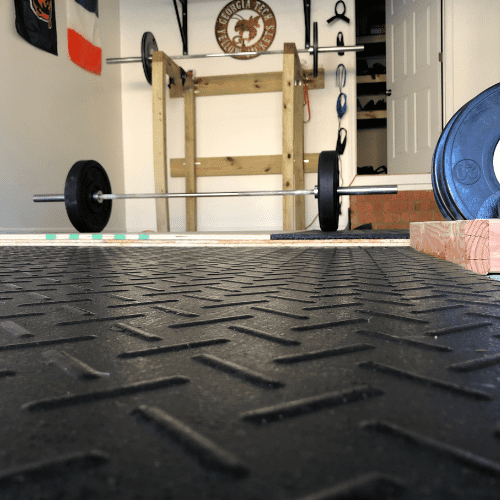
Tractor Supply Company Horse Stall Mats
Tractor Supply Mats come in 4′ x 6′ rectangles and are 3/4″ thick. The thickness is extremely important for a garage gym, especially if you plan on dropping weights.
The size of the mat is larger than Northern Tool and can cover a good amount of space with fewer mats.
They’re not as versatile, but they are a bit more cost-efficient. It really comes down to your specific needs and/or your preference in the look of one or the other.
Tractor Supply Horse Stall Mats come in 3/4 inch thickness and usually come in mats that are 4 x 6 feet each. The thickness is as good or better than most flooring designed for a garage gym and the mat size gives you a good amount of flexibility to get the mats to fit your space.
Here is the biggest advantage of TSC mats. You can pick up these mats for about $55 each. That’s the best price you’ll find for thick garage gym flooring, even slightly better than NorthernTool.
Are horse stall mats perfect? Of course not. They will move around on you a little bit, but this has never been a big issue for me. I may tap my mats back into place once every few months.
Most horse stall mats come with some type of design on them intended to give horses more traction than a smooth flat surface. This can cause the bar to jump around a tiny bit when dropped on the floor (until the “design” is beaten into submission from hundreds of dropped deadlifts and cleans!)
Finally, they’re going to stink when you first get them (like really bad), but that can be fixed pretty easily.
These issues, however, are minor inconveniences that are well worth the hundreds, if not thousands, of dollars that horse stall mats are going to save you.
Rogue Gym Mats – Best Mats For a Large Space
Need another heavy-duty mat option that’s not horse stall mats?
Look no further than Rogue’s Gym Mats.
These 4 x 6 foot, 3/4 inch thick behemoths weigh in at about 100 pounds a piece. Once you get these mats in place, they will take almost any kind of beating you could possibly dish out to them. I’ve worked out on these mats before and you couldn’t ask for much more for a garage gym flooring.
There are a couple of drawbacks to Rogue’s gym mats though.
Rogue sells these mats in bundles of 25. This will cover roughly 600 square feet which might be a lot more than you need. I have a two car garage that is barely over 400 square feet. Even with the bundle, the price still comes out to about $70 a piece.
So while these are seriously heavy-duty mats, they’re not cheap and you might have to get more than you really need.
If you’re outfitting a really large garage and don’t mind dipping into your wallet a bit, these Rogue Gym Mats are a great option.
Both of these gym mats are great options and the first two I would take a serious look at, but there are other good rubber gym flooring options available.
Let’s take a look at a few more.
Garage Gym Flooring – Interlocking Tiles
Tile flooring is a very popular option for home gyms, commercial gyms and even some college weight rooms. You can get them as either rubber tiles or foam tiles and it’s important to know which kind you’re getting if you purchase tile flooring.
Rubber tiles, if thick enough, can be just as durable as the heavy-duty mats we just discussed. However, many tiles sold as gym flooring are foam tiles. These tiles can work great if you’re doing very light activities, but NOT for lifting heavy weights.
The most obvious advantage to getting tiles (rubber or foam) is by working with smaller pieces it’s much easier to arrange your gym flooring to fit your space without having to do a bunch of cutting. This also leads to less wasted floor as well.
There’s another area where rubber floor tiles are better than the other types of garage gym flooring. Because all of the pieces interlock, it makes the installation of your gym flooring really easy and helps eliminate seams (space) opening up between pieces.
As I’ll discuss in a second, gym flooring pieces that are not interlocked, glued down or at least weighted down by heavy equipment have a tendency to “walk” away from each other and open up seams exposing the floor underneath.
Most of the time this shifting around of rubber mats (or even rubber gym flooring rolls) leads to more of an aesthetic issue than a functional issue.
However, when you do decide you want to fix the seams it’s a pain because pushing them back together can be much easier said than done when racks, platforms and other heavy exercise equipment are sitting on your gym flooring.
Finally, if you end up with an issue in one specific spot on your floor, tiles are typically much easier to take out and replace.
There are two tile options that I recommend if you do decide to go the tile route:
Anji MTX Exercise Platform Review

Anji MTX Exercise Platform
Excellent gym flooring option for at-home workouts utilizing cardio equipment, dumbbells and kettlebells.
Looks great. Performs great. Very easy to set up and take apart.
Does have limitations for weightlifters needing a more heavy-duty option.
There is a lot to like about this Anji MTX Platform.
First and foremost, the platform looks great. The design is clean, well made and looks very professional.
I have rubber stall mats in my garage gym and they look fine, but honestly, this platform reminds me more of what I’m used to in a collegiate weight room or commercial gym.
It is crazy fast and easy to set up. As soon as I got familiar with how the tiles linked together, it took me roughly 5 minutes to set up the whole platform and even less time to take it apart.
Because it’s so quick and easy to set up it could be a great option for someone in a small space. You could actually set up your platform, workout, and then store it away in a closet. It would be a great way to maximize your space.
For dumbbells, medicine ball slams and even using a trampoline (the one in the pic above) the platform held up great and was very solid.
It does have it’s limitations though. The hard plastic base under the platform didn’t hold up well to Power Cleans with a moderate amount of weight (176 pounds).
So, if you’re doing Olympic lifting or planning to drop Deadlifts I would still go with one of the stall mat options above, but if you simply need a really good looking gym floor to do more low impact workouts on, this platform is amazing.
For more info, check out my complete review of the Anji MTX Platform.
Prosource Fit Interlocking Tiles
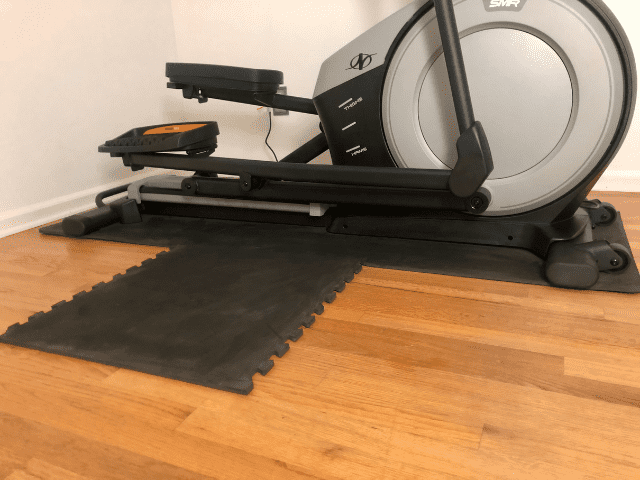
You can find this gym flooring option from Prosource online at Amazon. You can recognize this flooring because they come in small interlockable pieces (like a puzzle).
This gym flooring is a great low cost option for low impact workouts. If you’re doing yoga, bodyweight workouts and maybe using some light dumbbell then they can be a good choice.
We have a separate exercise room in our house (I know that seems a bit extreme) that houses an elliptical and my wife uses it for exercise videos and yoga.
We have the elliptical sitting on puzzle mat flooring and it works great for that purpose as well. As a garage gym floor, it will protect your floor from light dumbbells and keep you from having to workout on a cold concrete floor.
However, if you’re going to be lifting heavy weight, dropping bars, Olympic lifting, etc. these are NOT a good option.
Even though these tiles come in 3/4″ and 1″ thickness, the tiles are made of an EVA Foam and are not dense enough. The “cushion” in the pad is going to absorb force and will be detrimental to your lifts.
They are not designed for 250lb cleans or 400lb deadlifts dropped on them and will wear and tear pretty quickly if you try to put them through those types of lifts.
Garage Gym Flooring – Rubber Rolls
Rolled Mats are called such because they come in long rolls up to 50 feet a piece.
One of the advantages to rolls over tiles is cost.
When you compare equal quality floor, rubber rolls are usually always more cost-effective. (Having said that, as you’ll find out in a second, I don’t really recommend any of the budget rolled mat floors.)
Almost any large scale gym you go into, including colleges and universities, is probably going to have rolls as their rubber flooring.
PLAE Achieve

PLAE Flooring
If budget wasn’t a concern I would have PLAE flooring in my garage this very moment.
I’ve had PLAE flooring installed in multiple collegiate weight rooms and, in my opinion, it is the best of the best when it comes to gym flooring.
If you have the budget, give PLAE a serious look.
There’s only one type of rolled gym flooring that I will recommend and that’s PLAE. The last two college weight rooms that I’ve worked in have had PLAE installed.
In my opinion, it’s the absolute top of the line when it comes to weight room flooring. The design, look, performance and customer service sets them apart from everyone else, not to mention PLAE has a 15 year warranty on their flooring.
The PLAE Achieve line comes in 35′ x 4′ rolls (13mm) and 25′ x 4′ (18mm). They also come in three different levels depending on how intricate you want the coloring of your floor to be. The Level 1 is black and Level 2 and 3 gets more complex with it’s color schemes.
I do want to note though that Level 2 and 3 have a minimum order of 1200 square feet.
So unless you’re outfitting a four car garage, you’re going to need to go with the black. It also comes in three different thicknesses, 13mm, 18mm and 1 inch.
This quality isn’t going to come cheap though. Each roll of the Level 1 18mm runs over $700 (at the time of this writing) and will cover 100 square feet. Make no mistake, if the cost was not a concern, I would have 18mm PLAE floor in my garage at this very moment.
Garage Gym Flooring FAQ
Does Lowe’s or Home Depot Carry Rubber Gym Flooring?
What if you don’t have a Tractor Supply Company near you where you can pick up horse stall mats?
Do other popular home improvement big box stores like Lowe’s and Home Depot carry rubber flooring?
They do. Home Depot now carries a TrafficMaster Foam Shock Absorbent Gym Floor. This flooring comes in 25″ by 25″ interlocking rubber gym tiles and is 0.68″ thick.
Again, like the Prosource tiles I mentioned earlier, these are foam tiles and not dense rubber tiles. These will only be sufficient for light activities.
Lowe’s also has some rubber flooring options, but none of the thicker flooring that I would recommend for heavy lifting.
Remember, if you’re working out with light dumbbells, doing yoga and other light general purpose lifting, you can get away with having thinner flooring.
Heavy deadlifts, Olympic lifts or if you plan on dropping dumbbells or anything else after a set – invest in thick, high quality garage gym flooring.
How Thick Should Garage Gym Flooring Be?
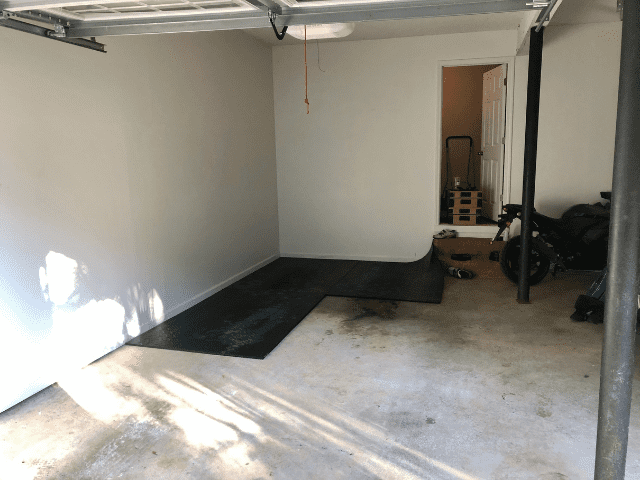
To protect your garage floor against the wear and tear of dropping weights you want a certain level of thickness. Standard gym flooring comes in a variety of thicknesses.
The most common thickness you’re going to come across when you’re shopping for flooring ranges from 8mm (equates to just under 3/8 of an inch) all the way up to 3/4 of an inch.
You can also find even thicker rubber flooring, but anything more than 3/4″ is really unnecessary. If you need thicker than that, say for a lot of Olympic lifting, invest in a platform. (Or build one yourself)
Don’t forget, thickness isn’t the only thing you have to be aware of. If you need heavy-duty flooring, almost all foam tiles that you’re going to find online or at big box stores will not be sufficient.
You need thick, durable rubber flooring.
So how thick do you need? Part of that depends on what you’ll be doing in your garage gym. If you’re going to be doing Olympic Lifting and/or CrossFit workouts then you want to opt for something thicker to guard against the daily dropping of bumpers and dumbbells.
You may even want a full-fledged platform to work on as well on top of the flooring.
If you’re going to be doing less intense work like light lifting and maybe even some yoga then you may not need as much thickness.
Regardless of what you’re doing, I think 8mm is really the thinnest that you’ll want. Anything less than that is not going to give your garage floor very much protection and very well could end up getting torn up and worn through pretty quick.
Keep in mind that gyms that use 8mm rubber flooring generally install a layer of padding underneath the mat itself. That’s not really an extra step that you probably want to do for your garage, nor do you really need to if you get flooring with enough thickness.
Thickness isn’t just about protecting your garage floor. A thicker floor will also generally help to deaden the sound of weight being dropped on it.
I don’t think I need to explain why this could be really important if you have people inside the house that may not want to hear your power cleans being dropped every 30 seconds. Especially, if those people are very tiny and take naps in the afternoon.
How to Clean Rubber Flooring

One of the best aspects of rubber flooring for a garage gym is how easy rubber flooring is to clean.
We have two dogs that both shed a pretty decent amount. Combine that with lifting with the garage doors open, making it easy for dust and dirt to come rolling in and my mats can get dirty pretty quick.
I like to sweep my gym flooring a couple of times a week, especially on days when I’m going to be doing floor exercises like floor presses or core work.
In addition to sweeping, I will fully mop down my home gym at least once a month. It doesn’t take anything fancy. A mop, water and some simple dish soap that you probably already have under your sink.
Once you’re finished, turn on a fan for about 30 minutes to help it dry and you’re done.
Final Thoughts on Garage Gym Flooring
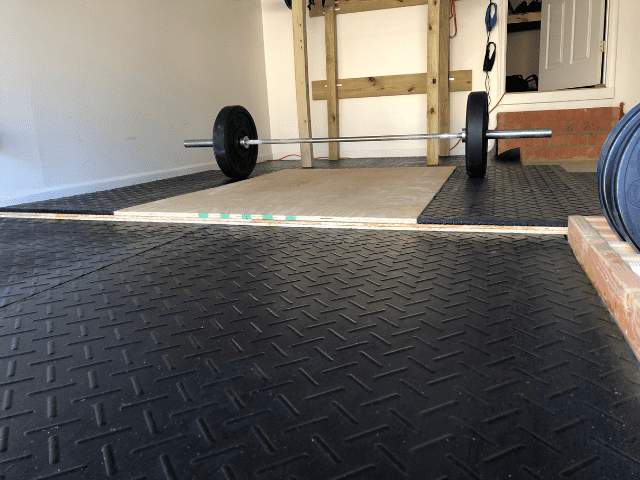
I went with Horse Stall Mats for my garage floor and am completely satisfied with my decision. Other than having to occasionally fix a seam, I’ve not had any issues with my floor.
Like I said earlier, if the cost was not a factor, I’d have PLAE rubber gym flooring rolls. But it is and I’d rather invest my money into a top of the line bar and bumpers.
At the end of the day, go with the floor that best fits your needs and your budget. Then enjoy that first lift on your new garage gym flooring!

